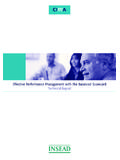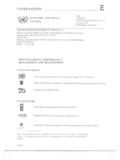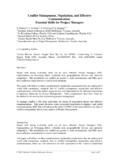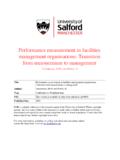Transcription of Effective Practices for Financial Management in the …
1 Jim Rosenberg, Principal Author Russell Willis Taylor, Editor September 2003 Summary Findings and a Framework for Self-Assessment ResearchLeadership Education for Arts and CultureLearning from the Community: Effective Financial Management Practices in the Arts Learning from the Community: Effective Financial Management Practices in the Arts Summary Findings and a Framework for Self-Assessment Jim Rosenberg, Principal Author Russell Willis Taylor, Editor September 2003 Executive Summary "After ten years with a tailwind, it s hard to adjust to being in a We're trying to figure out how you make smart decisions for the future in an environment where everything has changed." This is the challenge facing arts leaders today, in the words of one executive director we interviewed.
2 National Arts Strategies, with funding from The James Irvine Foundation, interviewed arts leaders to understand how Effective Financial Management Practices at leading organizations might be used across the sector to respond to this new environment. This paper introduces the Financial Management Practices we identified. While additional tools are needed to fully transfer Practices across organizations, this paper provides a framework that arts organizations can use to start evaluating their own approaches to Financial Management . The organizations investigated in this project are all very thoughtfully managed enterprises. Although they face similar challenges, their unique missions, strategies, and environments give them different priorities for Financial Management .
3 And, as is true for managers everywhere, arts leaders have limited time to explore emerging concepts. There are therefore opportunities for arts organizations to enhance their Financial Management through: A structured framework for assessing overall Financial Management practice The introduction of solutions worked out at other arts organizations The introduction of leading ideas from outside the arts for common challenges Benchmarking is a common approach for learning from other organizations in the arts sector. Our research suggests that while this numerical information is helpful and easier access to more accurate data is needed many Effective Practices cannot be captured through data alone. More direct methods for introducing ideas are needed.
4 Potential solutions include senior-level educational programs, peer learning opportunities, and the development of tools for self-assessment and implementation. This report outlines important areas to address in these leadership tools. Research Process NAS investigated the Financial Management approaches of a small but representative group of arts organizations. We conducted individual interviews with the executive directors, finance directors, and a sample of board members at thirteen institutions. Ten organizations were part of the Cornerstone Arts Organizations, a cohort of leading California arts institutions identified by The James Irvine Foundation. Three additional organizations with small annual budgets, a group that was underrepresented in the Cornerstone cohort, were selected from the NAS client base to create a more complete sample of the sector.
5 NAS also conducted desk research, reviewing publications on nonprofit and for-profit Financial Management to provide a framework for the Financial Management Practices identified during the interviews. Research Participants The participating organizations represented a broad range of arts disciplines, including fine art museums, cultural museums, multimedia arts organizations, orchestral music, opera, ballet, theater, arts presenters, and art colleges. Three organizations had annual Page 1 budgets of less than $1M, three organizations had budgets between $1M and $10M, and seven organizations had budgets greater than $10M per year.
6 The study focused on California organizations, but also included one East Coast and two Midwest organizations to create a sample that represented all budget sizes. Organizations came from three mid-size and two of the largest arts markets in the United States. Effective Practices in the Arts NAS pulled together the most Effective Financial Management Practices from across organizations to create a composite picture for an ideal arts organization. When these Practices are looked at together, a simple framework emerges for describing or designing a comprehensive Financial Management system. We can only touch on each practice briefly in this paper, and additional tools should be considered to help arts leaders use these concepts across the sector. Here we use the framework, structured as a series of questions, to step through these Financial Practices : A Framework for Assessing Financial Management Practice Financial Strategy 1.
7 What is the Financial Management culture of the organization? 2. What are the natural bounds on income for this organization? 3. What are the fundamental drivers of Financial risk and performance? Financial Planning 4. How does the organization finance its operations? 5. How does the organization choose projects and investments? 6. How are income forecasts created, and from them, annual budgets? Performance Evaluation 7. How is Financial performance tracked to support decision making? 8. How is long-term performance tracked and compared to peers? 9. How do board structure and processes impact Financial governance? Organizational Culture and Financial Management The norms and values of an organization s culture shape its processes and decisions. A culture that values creating a lasting organization as much as it values the artistic mission enables collaboration across disciplines and sound Financial decisions, to the benefit of both objectives.
8 The traditional conflict between artistic mission and Financial objectives creates a culture that misses opportunities to improve both Financial and artistic performance. In practice, building a culture that respects the Financial challenge as much as the artistic starts with the executive director. Consistent statements and actions by the executive director drive the norm through the organization. This can be a significant challenge in organizations with a separate artistic director and general manager; in this situation the value must be held as deeply and communicated as clearly by both leaders. In two organizations with long histories of balanced budgets, this leadership was easy to see. One executive director consistently talked about the Financial and Page 2 artistic together, describing their culture as artistically liberal and fiscally conserva-tive.
9 The other spoke less directly about culture, but set a clear tone by describing an organization that belongs to the community, and the place in the community he wants the institution to have years after he has retired and become just a patron. Financial Management culture starts with the actions of the executive director, but it is fully realized in the design of business processes. Leading organizations understand their Financial norms, and design processes that embody and sustain those values. In these organizations artistic excellence and organizational sustainability are aligned and mutually supported, not in conflict with one another. One such organization in this study with a preference for riskier Financial strategies invested in a very sophisticated Financial reporting system, following a norm that rigorous Management enables more risk taking.
10 The artistically liberal and fiscally conservative organization mentioned earlier tightly limits their total budget and holds managers strictly to their expense forecasts; together these processes realize their norm that artistic creativity is enhanced when Financial constraints and Financial promises are both taken as givens (energy is spent on the creative process rather than trying to push out the walls ). Strategic or long term planning is also a critical building block for an Effective Financial Management culture. While the Financial modeling done in this planning process is valuable, it is the focus and shared understanding of mission that this work brings to the organization that most impacts day-to-day Financial decisions. Discussions quickly focus on projects and opportunities that are in line with mission, allowing more time to be spent on the Financial analysis of this much smaller set of options.








